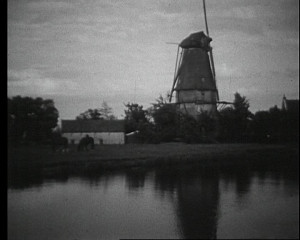
"A four reel film recording details of a motor tour undertaken by Eustace and Eunice Alliott through six of the twelve Dutch provinces" (EAFA Database).
"Mr Alliott responded by projecting yet another film, in colour, recording a visit to Holland, in which there were some excellent shots of Dutch scenery, including the gorgeous tulip fields. There were also many happy portraits of peasants and children in their quaint national costume." (Anon, Photographic Journal, 418)
[Information included on the EAFA database suggests that the film was partially shot using prismatic film which, when using red, blue and green filters on a Kodak A projector, a colour experience is possible. This includes the scenes of: Volendam, Marken, Alkmaar (lively cheeses), Sneek, Veere, Domburg etc.]
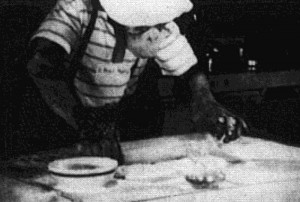
"J. Fred Muggs, a chimpanzee, undertakes to make and bake a pizza pie, and then eats it. Mr. Muggs at work may remind some of us of one or more events in the hazy past. He goes at the pie making with considerable proficiency although he is a bit of a comic. Like many cooks, he samples the ingredients as he works. Laughs enough for all" PSA Journal, Oct. 1961, 49
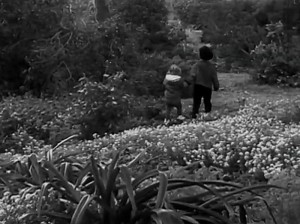
"We open with a little boy standing on a box in a telephone booth; his little friend is too busy or not of a receptive mood for the boy friend. Hurt as he is, he goes into the park and laments his failure to lure the young lady. He is about to resolve a life without women when a young (very young) girl comes into his perspective. His agile mind responds and he sets about to make an impression using many approaches of demure and sophisticated charm. His success was not exactly complete. Finally she visits the "girls" room. Her long delay is too much for the young man, so he makes another telephone call and hurriedly leaves the scene. The commentary is enhanced by the sophisticated French voice. This will be included in the Package" PSA Journal, Oct. 1962, 34.
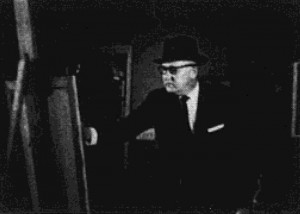
"A bit of humor comes to the fore when an artist, copying a famous painting, leaves his easel unattended. Sundry persons passing through cannot resist the urge to apply the pigment, just a helpful touch. Even the pictures on the wall take note of the goings on" PSA Journal, Oct. 1961, 49.
A Catalonian film by Mr. John Salvans about camping in the Pyrenees.
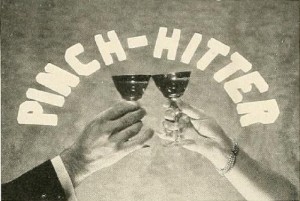
"Pinch Hitter, a photoplay by Charles J. Cafbonaro, has been given Honorable Mention because of its continuously sustained technical brilliance in the face of many problems of cinematic story telling. A suave situation comedy, it presents the dilemma of a girl who is asked once too often by her roommate to substitute for her on a temporarily undesired date. In time, the pinch hitter goes to bat for herself, knocks out a home run and leaves her roommate caught flat footedly out. In presenting this comedy of manners, Mr. Carbonaro has been helped by good acting from his players but hindered by not quite a light enough touch in the film's pace and direction. The lighting and camera work, which are genuinely of top flight quality, go far but not quite far enough in disguising this one weakness." Movie Makers, Dec. 1936, 550.
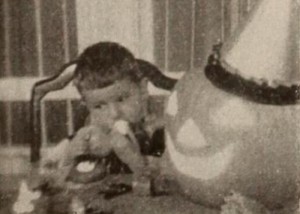
"To those filmers who have had the dubious honor of trying to direct a group of young, obstreperous children who somehow seem to persist in shyly gazing into the camera lens, Harlan M. Webber should be able to give some sound advice. Charming, but not cunning, Pinocchio's Jack-O'-Lantern seems to solve all the usual deficiencies which attend a film starring children. With a sure camera sense, Mr. Webber uses sparkling lighting and imaginative camera viewpoints to bring out the Peter Pan quality which pervades the Halloween party given by his son. The picture opens with startlingly clear shots of the small boy reading a Halloween book and continues with him helping his mother prepare the refreshments for the coming party. In a spirit of understanding and finesse, the filmer follows the antics of the disguised children through the party itself and on to the usual doorbell ringing, where they heinously blackmail the neighbors for candy, cookies and cake. Nostalgically provocative, the film exhibits a buoyant naturalness which would delight any audience." Movie Makers, Dec. 1946, 486.
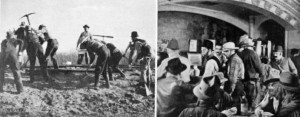
"Well, Pioneer Daze is all about building the first railroad between Winnipeg and Vancouver. It has no more regard for history than Cecil B. DeMille, but it is not nearly so grandiose about it, which is something to be thankful for." (Winnipeg Free Press)
"It was a prize winner produced by a group of employees of Brigden's Ltd., and gives their version of the building of the C.P.R." (Ottawa Journal)
Also referred to as "Pioneers Days, or Plates Wanted Thursday." (Ottawa Journal)
"Pioneers' Progess begins with the land rush into Oklahoma territory almost a century ago, then shows the result of this stampede and the progress that Oklahoma has enjoyed in the intervening years" PSA Journal, Sept. 1966, 35.
Total Pages: 299